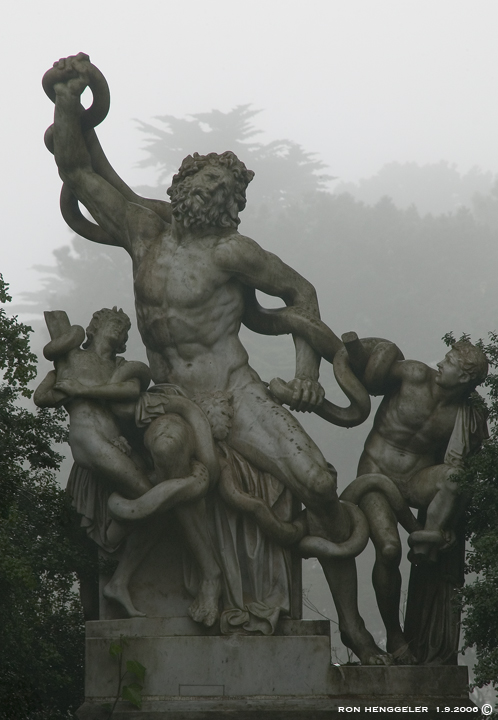RON HENGGELER |
December 14, 2006
The Laocoon... at the Legion of Honor
Laocoon and His Sons
This copy of the statue stands outside on the grounds of San Francisco's
Palace of the Legion of Honor. I photographed on January 11, 2006, the day
Anne Moffet and I went to see the AFTER THE RUINS show.
Laocoon and His Sons
Athanadoros, Hagesandros, and Polydoros of Rhodes
early 1st century
One of the major discoveries of the Italian Renaissance, this sculptural
grouping was lost for centuries but found 1506 near Rome, by a farmer
plowing a field in the ruins of Titus' palace. It depicts an event in
Vergil's Aeneid (Book 2). Michelangelo (1475-1564) had been in Rome twice,
(1505-06) to start work on the Tomb of Pope Julius II; on that visit he and
the pope, upon hearing the news of the Laocoon discovery, rode horseback
outside of Rome, to witness the unearthing of the ancient Laocoon Group.
Realizing that the sculpture was indeed the long lost famous Laocoon, it was
mounted on a special wagon and brought back into Rome with a traditional
hero¹s welcome. Along with the ticker tape parade¹, there were three days
of city wide celebrations.
Laocoon in Greek Mythology
Laocoön was an intriguing character in Greek mythology. He played a small
but significant role in the notorious Trojan War, and his memorable
contributions to myth were celebrated in a famous Hellenistic statue. Read
on to learn more about this legendary figure.
According to ancient authors, Laocoon was a blind Trojan priest of Poseidon
(note, however, that some sources claim that he was instead one of Apollo's
priests). In mythology, Laocoon was the brother of the hero Anchises and son
of Capys. One of our best sources for the story of Laocoon is found in
Virgil's Aeneid. In this epic tale, the Roman poet Virgil describes the
dramatic scene in which the Trojans discover an enormous Wooden Horse
standing outside the city of Troy. The prescient priest Laocoön warns
against bringing the gigantic Horse into Troy in a famous speech:
"'O my poor people,
Men of Troy, what madness has come over you?
Can you believe the enemy truly gone?
A gift from the Danaans, and no ruse?
Is that Ulysses' way, as you have known him?
Achaeans must be hiding in this timber,
Or it was built to butt against our walls,
Peer over them into our houses, pelt
The city from the sky. Some crookedness
Is in this thing. Have no faith in the horse!
Whatever it is, even when Greeks bring gifts
I fear them, gifts and all.'"
(Virgil, The Aeneid, Book II, 59-70)
Immediately after saying these words, Virgil has Laocoon hurl his spear into
the flank of the Wooden Horse. However, this gesture was to come back to
haunt Laocoon. For soon after this incident, while the priest is sacrificing
to his god Poseidon, a pair of giant sea serpents emerge from the sea and
envelope both Laocoon and his two sons (this tragic scene is immortalized in
the Hellenistic image). The Trojans interpret this grotesque punishment as a
sign that Laocoon offended the gods - either Athena or Poseidon in
particular - for attacking the Wooden Horse. In the end, the Horse is
brought into Troy, which is a fatal mistake and seals the city's doom.
|
Newsletters Index: 2015, 2014, 2013, 2012, 2011, 2010, 2009, 2008, 2007, 2006
Photography Index | Graphics Index | History Index
Home | Gallery | About Me | Links | Contact
© 2015 All rights reserved
The images are not in the public domain. They are the sole property of the
artist and may not be reproduced on the Internet, sold, altered, enhanced,
modified by artificial, digital or computer imaging or in any other form
without the express written permission of the artist. Non-watermarked copies of photographs on this site can be purchased by contacting Ron.
